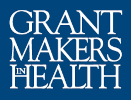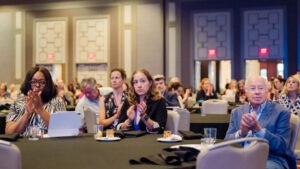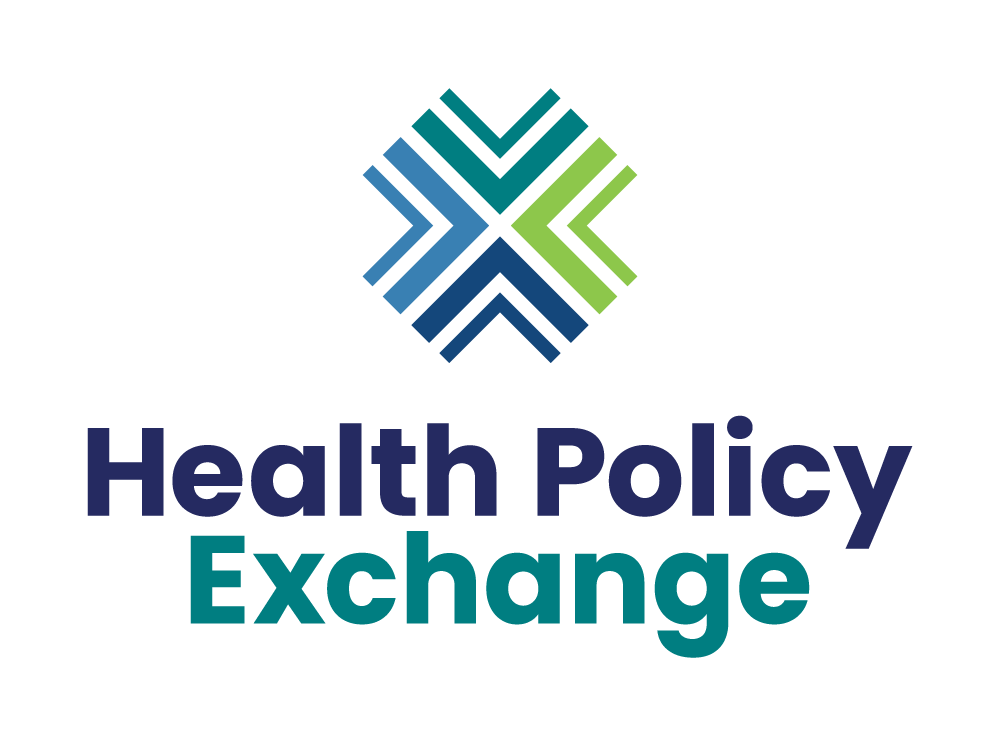“Build a future in which all of our descendants have the opportunity to lead a healthy and productive life.” – Cara V. James, President & CEO of Grantmakers In Health
The final day of the Grantmakers In Health (GIH) 2025 Annual Conference on Health Philanthropy focused on milestone moments in health like the 20th anniversary of Hurricane Katrina and elevated the philanthropic partnerships already inspiring a better tomorrow. While much of the conference was spent reflecting, today was marked by action and what comes next: standing firm in values, being courageous, and co-creating a vision for the future.
As GIH President and CEO Cara V. James noted in her closing remarks, the conference was successful in part because of the host committee, conference organizers, and session designers, but mainly due to the energy and commitment of our largest number of conference attendees ever. The strength of our community was felt at every Quick Take, Breakout Session, hallway conversation, and even out on the historic streets of New Orleans. More than ever, this year’s conference attendees embraced Grantmakers In Health’s mission to help the philanthropic field learn, connect, and grow. We look forward to continuing the discussions throughout the year, at the upcoming Health Policy Exchange in Washington, DC (November 19 – 21, 2025), and at the 2026 GIH Annual Conference on Health Philanthropy in Baltimore, Maryland.
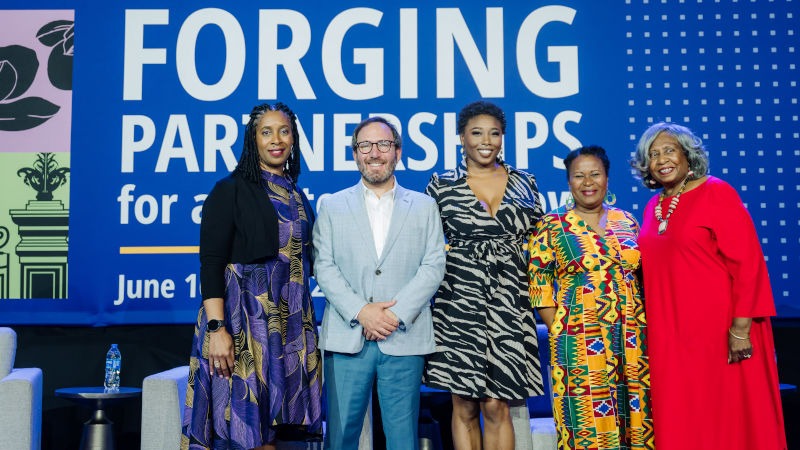
Plenary: 20 Years of Rebuilding Since Hurricane Katrina
Nearly 20 years ago, Hurricane Katrina made landfall in Louisiana, Mississippi, and Alabama. As moderator Charisse Gibson, Evening News Anchor at WWL-TV, put it, “disaster exacerbates disparity.” Katrina was certainly no different.
In this final plenary, panelists explored the lessons learned from Katrina and how they apply to our current and future disaster preparedness and recovery efforts. Read on to find the top takeaways from their conversation.
Rebuilding from an Equitable Base
The systems we live, work, and play in today were not built with equity in mind. But as we build new structures, it’s our responsibility to do things differently. Take the Foundation for Louisiana: formerly known as the Louisiana Disaster Recovery Foundation and founded in 2005 in response to Hurricanes Katrina and Rita, an essential element of this organization is its charter. As long as the foundation is making grants, it is required to do so through an equity lens.
Linetta Gilbert, Managing Partner at Gilbert & Associates, is a respected leader in the philanthropic community and played a role in launching the foundation. Through this work, she and her fellow founders not only provided urgent support to recovering communities, but also ensured that Louisiana’s marginalized communities would be supported in the future.
Bottom Line: No matter the disaster, it’s essential to pair rapid response with long-term planning.
Thinking Beyond Government Infrastructure
While many people in the United States have never been able to rely on the government for support, community-based programs have always provided a strong alternative. On a note of hope, Gilbert shared that even with significant cuts to Medicaid, “there are other ways [to access healthcare] – community-level ways.”
Often, funders find themselves filling the gaps left behind by the government. And while this is important work, it’s also the role of philanthropy to reimagine systems altogether, outside of the government’s traditional infrastructure. This is especially true now. Joseph Kanter, CEO of the Association of State and Territorial Health Officials, described health philanthropy’s work in the current moment as “not fixing gaps, but dealing with the eradication of systems.”
Bottom Line: Don’t wait for the government to act, or spend ample resources urging them to fill essential funding gaps. Find your own place-based solutions.
Expanding to Various Kinds of Support
Charmel Gaulden, President & CEO of the Foundation for Louisiana, emphasized the importance of thinking beyond traditional grantmaking. Consider:
- Combining forces to respond to a widespread issue. Katrina was a regional disaster that required the impacted states to work together. The same is true for the disasters of the present and future.
- Committing to sustained funding. Disasters often make way for a very long, complicated road to recovery. Funders must go on this journey alongside the communities they support, from start to finish.
- Providing non-monetary support. Money is essential, but funders hold additional powers that they can use to influence better outcomes for communities. You can use your relational capital in many ways, including bringing fellow funders into the fold to expand your impact.
Bottom Line: Step out of your silo. Collaboration and community-focused thinking yields stronger outcomes.
Restoring Community Connections
Through all kinds of crises, from Katrina to COVID-19, community members have found ways to share resources and information. Investing in infrastructure that supports strong connections among community members before disaster strikes is essential to ensuring people are supported during and after an event occurs.
Bottom Line: In Gaulden’s words, “Tie yourself to your community.”
In closing, Gibson asked each of the panelists to share one final lesson from Katrina that’s applicable to our current and future disaster recovery efforts:
- We need each other in this work.
- The people who are most impacted by disasters must be the ones driving the campaigns to recover from these disasters.
- Even in the darkest moments of disaster, know that we have the power to build back better.
Medicaid Funding for Social Determinants of Health
While much of the U.S.’s current care model is rooted in clinical maintenance and prevention, Nora OBrien-Suric, President of the Health Foundation for Western and Central New York, introduced a different vision during this session: one that balances clinical care with discrete interventions outside the clinic that can address social determinants of health.
Funders across the country have established replicable models for integrating social care interventions into health care.
Susan Mims, President and CEO of the Dogwood Health Trust, introduced one such intervention that Dogwood funded: the Healthy Opportunities Pilot (HOP). With a mission of improving the health and well-being of communities in Western North Carolina, Dogwood established a 501c3, Impact Health, to implement the pilot and make it possible for Medicaid dollars to fund more than clinical care. Laurie Stradley, CEO of Impact Health, shared that the unique pilot provided key services, including food, housing, and interpersonal safety classes to improve health outcomes and reduce healthcare costs for Medicaid members. In just three years, HOP has served nearly 11,000 participants and has the potential to save the state $11.9 million annually in healthcare savings.
June Simmons, CEO of Partners in Care Foundation, shared similar successes in bridging the gap between medical care and community-based services. She discussed CalAIM, a series of initiatives aimed at expanding access to coordinated and equitable care for all Californians. The initiatives have faced challenges: fragmented communications, a lack of integration, and client retention issues. However, these scalable, high-impact care initiatives have also shown growing enrollments, better referrals and data sharing, and on-track implementation.
Nikki Kmicinski, CEO of Western New York Integrated Care Collaborative, Inc., has had similar successes in her state. Building a collaborative of community-based organizations to bring clinical care to where people are has improved health outcomes, and reduced healthcare costs in Western New York.
Panelists noted that making this kind of change in the health system can take time, but there is also an appetite, especially from care managers and community organizations, to do something new. Funders can support enthusiasm for early interventions with sustained and flexible funding since cash flow from the state is often delayed and restrictive.
While one attendee suggested these interventions were a “philanthropic homerun,” panelists did not sugarcoat the funding challenges. Some panelists suggested that getting started, showing results, and finding a trustworthy partner is difficult, and some funders do not understand the importance of social services and may downplay the need for holistic care.
To ensure the success and sustainability of integrative community care programs, panelists suggested:
- Staying close to policymakers who make decisions about state budgets and funding.
- Remaining several steps ahead of federal decisions around Medicaid and Medicare.
- Considering sustainability in plans and proposals before the first check is even written.
- Building enough volume for a shared infrastructure that will pay for services.
- Leveraging the network to assess new services, fee schedules, and potential partners to help ensure patients can bill for care management.
- Serving as conveners and connectors for CBOs, healthcare providers, payers, and patients.
Building Power: Lessons from an 8-Year Immigrant Health Campaign
In 2016, the Center for Health Progress (CHP) embarked on a long-term mission to secure healthcare coverage for undocumented immigrants in Colorado. Early on, Joe Sammen, Co-Executive Director of CHP, and his team recognized that in order to achieve their goal, the organization would need to shift to a “power-building” strategy. But what does this truly mean, and what does it look like in practice?
Sonia Sarkar, Founder of Healing Capital, developed a case study about CHP’s approach to their mission, and in doing so identified three core attributes of successful power-building:
- Positioning people with lived experiences to drive the campaign strategy.
- Moving beyond intellectualizing and into training, organizing, and action.
- Adopting a democratic decision-making model to ensure community members have a direct say in campaign outcomes.
Power-building work isn’t without its challenges, and organizations like CHP need long-term support from values-aligned funders to achieve their ultimate goals. However, in order to forge a successful partnership, there are several core commitments that funders must make. Joe, Sonia, and moderator Jennie Riley, Executive Director of the Rx Foundation, shared the following advice for funders:
- Do your research. Understand the history of power-building and what this work requires in your specific community.
- Join for the long run. Building power takes time and sustained resources. Long-term support enables organizations to not only start their ambitious projects, but achieve their biggest goals.
- Understand the difference between general operating support and capacity-building support, and the importance of both. General operating support is essential to seeing a campaign through to the finish, but capacity-building support is what enables organizations to continue making an impact beyond the campaign.
You Thought You Were Safe: Health Funders at Risk
Since January 2025, several GIH Funding Partners have experienced public-facing attacks, making it clear that philanthropic organizations are currently vulnerable to risk. This late-breaking session was formed to quickly and intentionally provide the practical tools that many organizations need now.
To set the foundation, Farhana Khera, Civil Rights Attorney at the Freedom Economy, separated fact from fiction around circulating threats to organizations:
- DEI programs remain lawful today.
- Only the IRS can revoke a 501 (c) (3) tax status.
- The President cannot freeze bank accounts.
Part of staying informed is assessing legal, business, reputational, and security risks—right now and as an ongoing practice. While organizations may use different approaches, Khera offered one memorable framework: Risk, Reward, Response.
- Name the risk in detail
- Identify the corresponding reward for taking on the risk
- Describe how the organization can mitigate and respond to the risk.
Khera and speaker Whitney Tome, Managing Principal of Culture, Strategy & Organizational Design at Raben agreed that whatever framework organizations choose, effective risk assessments are typically focused and small, including key leaders, the governing board, and relevant experts.
Risk assessments are powerful tools for understanding what an organization can adequately handle, both publicly and privately. However, a risk assessment is only as good as the strength of an organization’s values. Tome suggested using the risk assessment to identify what your organization is willing to risk, how much, and how far. To withstand attacks, organizations must balance standing in values while mitigating risk. Tome even challenged the idea that risk is inherently scary, sharing, “Sometimes, risk can be wonderfully audacious.”
Bottom Line: Bad faith attacks and unlawful exercises of power will continue, but being smart about risk can help organizations focus on what matters, continue mission-driven work, double down on values, and provide holistic support for all of the organization’s stakeholders.
Advancing Health Equity for Rural Children Through School-Based Oral Health
Children living in rural areas of North and South Carolina face unique challenges and barriers to accessing oral health care. To address this persistent issue, the Medical University of South Carolina, the Duke Endowment, and the BlueCross BlueShield of North Carolina Foundation developed a school-based oral health program, enabling children to access care right where they spend most of their time. The grant program provides robust support to its grantees, ensuring participating providers are positioned to deliver essential care in the near-term and sustain their practices for the long term.
The program has had great success. Grantees have provided about 109K prevention services to nearly 8K children in the Carolinas. And while the initiative is now at a stage of significant expansion and impact, the journey there wasn’t without its challenges.
In this session, Amy Martin, Professor and Chair of the Department of Biomedical and Community Health in the College of Dental Medicine at the Medical University of South Carolina; Daijah Davis, Director of Oral Health at the BlueCross BlueShield of North Carolina Foundation; and Stacy Warren, Associate Director for Health Care at the Duke Endowment, shared several insights for funders who are working to get their organizations to commit to deeper place-based impact.
- Share the stories. Warren shared that at first, the Duke Endowment was hesitant to fund a school-based program, since they typically focused on big health systems. But when Warren shared the stories of rural kids in the Carolinas, and illustrated the critical health challenges they face, the Endowment was able to see the bigger picture, and their essential role within it.
- Maintain enthusiasm. Davis encouraged program leaders to regularly articulate the impact of their work to foundation leadership. If leadership can track the effectiveness of their commitment, they’re more likely to stay for the long-run of the program. This is especially effective when weathering unforeseen but unavoidable challenges, like a storm or a pandemic.
- Suggest partnerships. No one funder is knowledgeable on every issue. Partnerships with fellow funders who have different areas of expertise are an effective and efficient way to deepen impact.
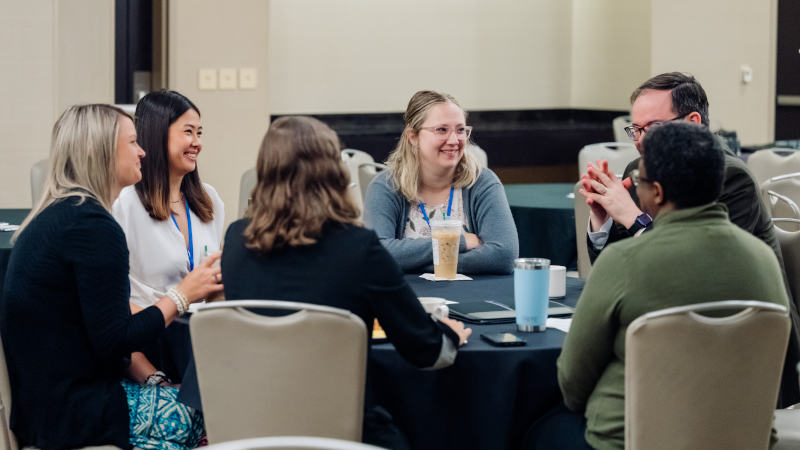

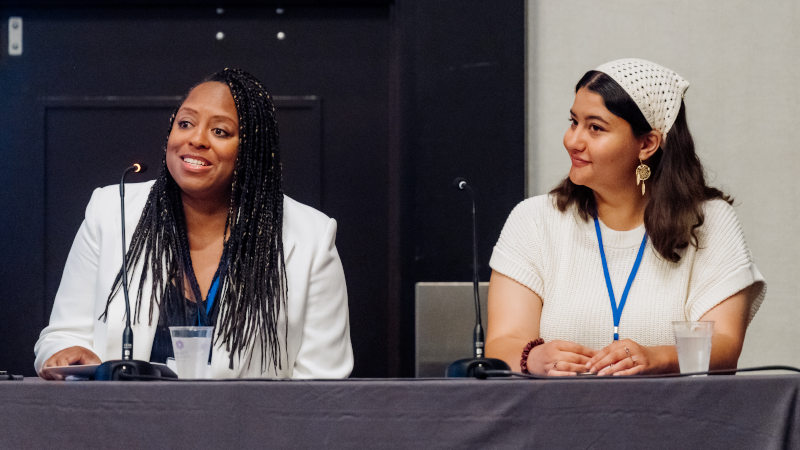
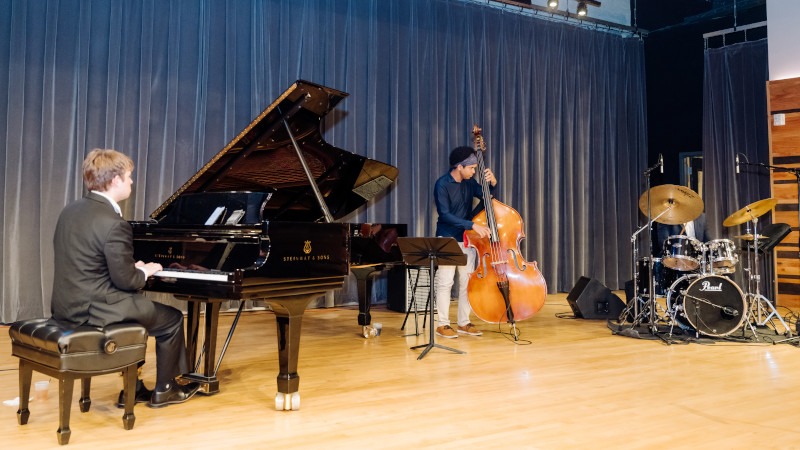
In Conclusion
Cara James, President & CEO of Grantmakers in Health, concluded the conference on a note of hope. Despite the challenges of the current moment, James urged attendees to lean into a vision for our future: “A vision that’s co-created by all of us, centered in community, with the voices of community, to build a system that works for all of us.”
James also reminded attendees to lean into their GIH community to continue forging connections and to reach out for support when it’s needed.
Save the Dates
2026 Annual Conference on Health Philanthropy

June 8 – 12, 2026
Baltimore, Maryland
(Photo by Matthew Binebrink)
Baltimore Fact: The birthplace of the U.S. national anthem, “The Star-Spangled Banner,” is Fort McHenry in Baltimore’s Inner Harbor.
Continue the conversations and engagement on GIH socials and the official GIH Annual Conference app.
Facebook | LinkedIn | Instagram | Conference App
